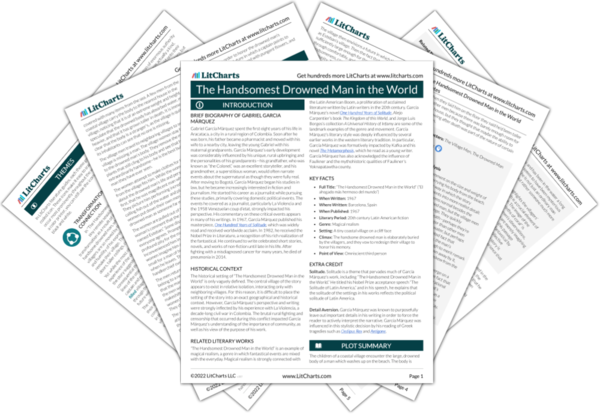In “The Handsomest Drowned Man in the World,” a tiny remote seaside village experiences a profound transformation as a result of its encounter with a huge and handsome drowned man, whom they name Esteban. The villagers are so moved by the splendor of the man’s appearance and humility of his expression that they decide to radically remake their village. They aim to honor his memory with wider doors, taller ceilings, colorful walls, and extensive flowerbeds.
Yet while the most obvious consequence of the village’s experience of the drowned man is this planned physical change, the story suggests that the village’s transformation is more consequential than a mere renovation of appearances. The final lines of the story imagine, from the perspective of the village, a captain and passengers observing the now beautiful, flower-filled village and identifying it as Esteban’s village. A village that through the story was unknown, tiny, and nameless, in the future will be noteworthy and named.
The villagers who imagine this future clearly anticipate that their experience with Esteban will come to define their community. The physical renewal of their village is, understood in this light, just a physical manifestation of the closer ties the villagers have formed through their experience of the central events of the story. While initially in the story the villagers quarrel over small issues (such as the name of the drowned man, the speed at which they should prepare the body for sea burial), by the end of the story they are in clear and unanimous agreement—they all recognize Esteban’s miraculous beauty and sincerity and plan to commemorate him by changing their own lives and village. The changes that the village undergoes are a clear testament to the transformative power of the villagers’ shared experience. By illustrating this, the story suggests that strong, shared cultural experience and stories—what might be described as a communal founding myth—can transform group identity by creating connection and a shared vision.
Transformation, Myth, and Connection ThemeTracker

Transformation, Myth, and Connection Quotes in The Handsomest Drowned Man in the World
They did not even have to clean off his face to know that the dead man was a stranger. The village was made up of only twenty-odd wooden houses that had stone courtyards with no flowers and which were spread about on the end of a desertlike cape.
As they were doing that they noticed that the vegetation on him came from faraway oceans and deep water and that his clothes were in tatters, as if he had sailed through labyrinths of coral.
They only had to take the handkerchief off his face to see that he was ashamed, that it was not his fault that he was so big or so heavy or so handsome […]. There was so much truth in his manner that even the most mistrustful men, […] even they and others who were harder still shuddered in the marrow of their bones at Esteban's sincerity.
At the final moment it pained them to return him to the waters as an orphan and they chose a father and mother from among the best people, and aunts and uncles and cousins, so that through him all the inhabitants of the village became kinsmen.
While they fought for the privilege of carrying him on their shoulders along the steep escarpment by the cliffs, men and women became aware for the first time of the desolation of their streets, the dryness of their courtyards, the narrowness of their dreams as they faced the splendor and beauty of their drowned man.











